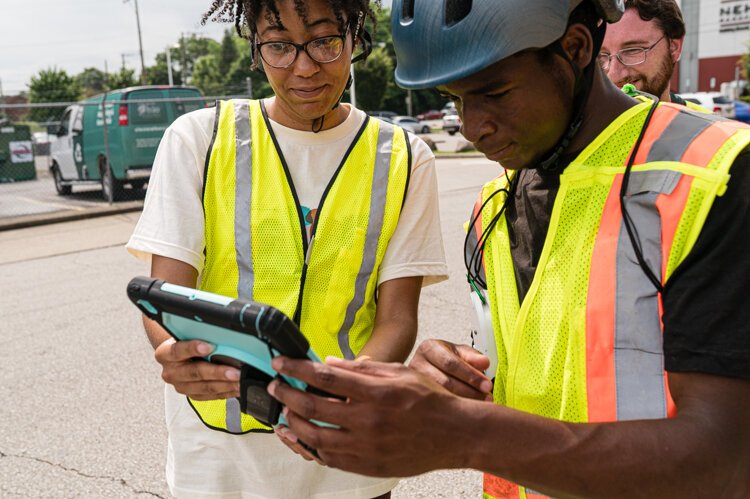Home with your kids? Make the most of it.
Liz McEwan, regular Soapbox contributor and homeschooling mom with four children, shares her survival tips for the upcoming weeks.
With Ohio schools closed and many parents working from home or temporarily out of work, life looks very different for many Cincinnati families right now.
Local residents with school-aged children are facing not only the initial questions of how to manage their own work schedules and childcare options, but also the looming possibility of an extended time sequestered at home with their children due to the COVID-19 pandemic.
What we’re facing right now isn’t exactly an extended spring break.
First of all, there’s nowhere to go. You can forget spending an afternoon at the art museum or a leisurely brunch at the cafe and you can’t catch a last-minute cheap flight to Disney World. Play dates are probably out of the question for a little while, as are weekend trips to Grandma’s house.
So what does it look like to be home all day with children? And how is it possible to keep everyone occupied and happy, while still taking care of daily responsibilities like chores, parents’ work, and schoolwork?
Because I’m a homeschooling stay-at-home mom, some of my friends have already inquired about how families like mine structure our days to make room for lessons and other work without going crazy.
I’m currently teaching three of our children — first, third, and fifth grade — and I have a three year-old, as well. But, to be clear, I’m not an expert. I can’t speak for anyone else because every family is different. I can only tell you what works for us.
How to get schoolwork done without the struggle
It’s probably important to clarify that online school is not the same as “homeschool.” When I withdrew my children from public school with the intent to homeschool, I took on full responsibility for choosing their curriculum, directing their lessons, etc. We have the flexibility of doing many of our lessons together as a group and I can adapt our academics on a daily basis if I need to.
For those whose children are enrolled in school, their teachers should be providing any necessary instruction they’ll need to complete at home. I can’t advise you about how closely you need to follow these lessons nor how seriously you need to take their school work at this time.
Their teachers will probably provide video lessons or easy-to-follow worksheets or student-led assignments. At this point in the school year, your kids should be familiar enough with the subjects to help you understand how to help them. You will be more of their tutor than their instructor. You won’t choose their lessons, but it will be your job to make sure they get their work done.
Academically speaking, my simplest advice is this:
Do hard things first. If there is a subject your child is struggling with, tackle it earlier in the day to get it out of the way. We do most of our independent work — the work that requires a lot of personal attention from me — in the morning. I rotate through helping each child while they take turns helping occupy the three year-old.
Keep lessons short. It’s normal for a child to lose interest in a subject after 15–20 minutes. Don’t expect your second grader to sit still at the table for three hours with worksheets unless it comes naturally for them. If your child begins to struggle too much and can’t get to the end of a lesson, stop. Take a break and come back to it later in the day.
Schedule breaks and snack times. Put two or three focused activities or subjects in a row and then force your kids to take a break. Play outside or take a walk at least once a day. Make a snack available midway between meals so the kids don’t just grab a granola bar ten times a day out of boredom or habit.
We like to use our afternoon snack time, for example, as a family teatime. We gather at the kitchen table, serve each other tea (or coffee or hot cocoa) and we read our favorite stories or poetry together. It’s a great way to reconnect and close out our “school day.”
Switch up the location of your lessons to stave off boredom. For older kids especially, let them do independent reading alone in their bedroom, do worksheets at the dining room table, watch their videos on the couch in the living room, and take some lessons outside.
Ask for help when you need it. There’s a reason so many of us who homeschool join co-ops with other homeschooling families. We can’t do this alone. Your kids’ teachers will be available to help. So will many of your friends and family. Lean on people with expertise that you don’t have. Call your friend who teaches sixth grade math when there’s something you don’t understand. Let your kids call their friends to work on lessons together.
Look up online lessons and tutorials when you need to. The internet is full of resources for schooling at home and many of these services are offering free and discounted subscriptions during this chaotic time.
If all else fails, toss the plans out the window, quit the lessons for a bit, and just enjoy being together. This is an unprecedented opportunity to refocus your family on what really matters if you don’t let “school” get in the way.
Reconsider what family life looks like during this season
This is where homeschool families can be your best resource. Homeschooling, after all, is not just a different way to educate; it’s a completely different lifestyle. It might not work for you in the long-term, but there are simple ways to make this a sweet and fruitful season by reframing your time together as if you were truly “homeschooling.”
First, put down the iPad and turn off the tv, at least as your first resort. Go for a hike or break out the art supplies. Focus on a new or beloved hobby or start a family project. Let your kids build a fort in the backyard or help them design a treehouse. Start a nature journal as you watch spring arrive.
Instead of TV shows, try audiobooks or start reading a favorite book aloud. Instead of video games, try board games or puzzles. Listen to music. Learn a dance together. When you do turn on the tv, use it to share the things you love instead of mindless consumption. Pull out family videos or let the kids watch the shows you watched on sick days as a kid. Let your children make their own videos or short stories of their experience of self-quarantine.
Slow down and establish a new family rhythm. If you’re anything like the average American family, you’ve spent many of your days too busy to connect — running errands, driving kids to activities, and passing each other as you go in and out of the front door.
This is your chance to re-establish some basic routines together. Engage your kids in household responsibilities and chores that are usually managed around them or without them. Let them help with preparing meals and then learn to enjoy unhurried family time around the table.
Let’s be honest
Don’t misunderstand me, though. Even if this can be a fruitful time for your family, that doesn’t mean it will be easy. This will be a difficult season for all of us, in many different ways. After the initial shock wears off, it will get boring, frustrating, and really hard at times. (As I write this, I have one kid crying in the other room. This is totally normal for 3 p.m. on a long day.)
Not every day at work is a good day, right? This is your new “work,” so embrace it. Bad days — even really bad days — don’t mean you’re doing something wrong. It can be good and hard at the same time.
Be patient with yourself and with each other. Be flexible and reasonable with your expectations. Be willing to pivot and change your plan for the day to take care of yourself and each other. When things get tense between them, give your kids time apart. When you need it, take time and space for yourself and for you and your partner.
Just take it one day — or one hour — at a time. You’ll get through this.


















